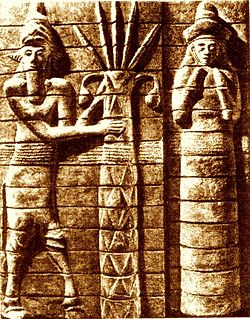Ninhursag
In Sumerian mythology, Ninhursag (NIN.URSAG) was the earth and mother-goddess, one of the seven great deities of Sumer. She is principally a fertility goddess. Temple hymn sources identify her as the 'true and great lady of heaven' and kings of Sumer were 'nourished by Ninhursag's milk'. She is typically depicted wearing a horned head-dress and tiered skirt, often with bow cases at her shoulders, and not infrequently carries a mace or baton surmounted by an omega motif or a derivation, sometimes accompanied by a lion cub on a leash. She is the tutelary deity to several Sumerian rulers.
Names
Ninhursag means "lady of the mountain" (from Sumerian NIN "lady" and ḪURSAG (or ḪUR.SAG) "sacred mountain"). She had many names including Ninmah ("Great Queen"); Nintu ("Lady of Birth"); Mama or Mami (mother); Aruru (sister of Enlil); Belet-Ili (lady of the gods - Akkadian). Minor synonyms include Ninzinak (lady of the embryo); Nindim (lady fashioner); Nagarsagak (carpenter of insides); Ninbahar (lady pottery); Ninmag (lady vulva); Ninsigsig (lady of silence); Mudkesda (blood-stauncher); Amadugbad (mother spreading the knees); Amaududa (mother who has given birth); Sagzudingirenak (midwife of the gods); Ninmenna (lady of the diadem). According to legend her name was changed from Ninmah to Ninhursag by her son Ninurta in order to commemorate his creation of the mountains. As Ninmenna, according to a Babylonian investiture ritual, she placed the golden crown on the king in the Eanna temple.
Some take the view that Ki (earth) the primordial goddess of the earth and consort of An (heaven), was identical to or an earlier form of Ninhursag. This may very well be the case, since some authorities argue that Ki was never regarded as a deity in her own right in the historical period. There is no evidence of a cult for the goddess and the name appears in a limited number of Sumerian creation texts. This sort of syncretisation can lead to confusion; as Ki, Ninhursag would be the mother of Enlil, whereas in other sources she is his sister.
Some of the names above were once associated with independent goddesses (such as Ninmah and Ninmenna), who later became identified and merged with Ninhursag, and myths exist in which the name Ninhursag is not mentioned. She also seems to have been identified with Ninsar (=Lady Greenery) and Ninkurra (=Lady Pasture) or even Uttu (=the spinner), her daughters in the tale of Enki and Ninhursag.
Mythology
| Fertile Crescent myth series | |
|---|---|
| Mesopotamian | |
| Levantine | |
| Arabian | |
| Mesopotamia | |
| Primordial beings | |
| The great gods | |
| Demigods & heroes | |
| Spirits & monsters | |
| Tales from Babylon | |
| 7 Gods who Decree | |
|
4 primary: |
3 sky: |
In the legend of Enki and Ninhursag, Ninhursag bore a daughter to Enki called Ninsar ("Lady Greenery"). Ninsar bore Enki a daughter Ninkurra. Ninkurra, in turn, bore Enki a daughter Uttu. Enki then pursued Uttu, who was upset because he didn't care for her. Uttu, on her ancestress Ninhursag's advice buried Enki's seed in the earth, whereupon eight plants (the very first) sprung up. Enki, seeing the plants, ate them, and became ill in eight organs of his body. Ninhursag cured him, taking the plants into her body and giving birth to eight deities: Abu, Nintulla (Nintul), Ninsutu, Ninkasi, Nanshe (Nazi), Dazimua, Ninti, and Enshag (Enshagag).
In the text 'Creator of the Hoe' she completed the birth of mankind after the heads had been uncovered by Enki's hoe.
In creation texts Ninmah (another name for Ninhursag) acts as a midwife whilst the mother goddess Nammu makes different kinds of human individuals from lumps of clay at a feast given by Enki to celebrate the creation of humankind.
Worship
Her symbol the omega (Ω) has been depicted in art from around 3000 B.C.E., though more generally from the early second millennium. It appears on some boundary stones - on the upper tier, which indicates her importance.
Her temple, the E'Saggila (from Sumerian E = House, SAG = Sacred, Ila (Akkadian) = Goddess), was located on the Khur (sacred mound) of Eridu, although she also had a temple at Kish.
KI
Cuneiform KI (Borger 2003 nr. 737; U+121A0 𒆠) is the sign for "earth," but also "place location." It is also read as GI5, GUNNI (=KI.NE) "hearth," KARAŠ (=KI.KAL.BAD) "encampment, army," KISLAḪ (=KI.UD) "threshing place" and SUR7 (=KI.GAG). In Akkadian orthography, it functions as a determiner for toponyms and has the syllabic values gi, ge, qi and qe.
See also
- Ereshkigal
- Eve (Bible)
ReferencesISBN links support NWE through referral fees
- Michael Jordon, Encyclopedia of Gods, Kyle Cathie Limited, 2002.
External links
Credits
New World Encyclopedia writers and editors rewrote and completed the Wikipedia article in accordance with New World Encyclopedia standards. This article abides by terms of the Creative Commons CC-by-sa 3.0 License (CC-by-sa), which may be used and disseminated with proper attribution. Credit is due under the terms of this license that can reference both the New World Encyclopedia contributors and the selfless volunteer contributors of the Wikimedia Foundation. To cite this article click here for a list of acceptable citing formats.The history of earlier contributions by wikipedians is accessible to researchers here:
The history of this article since it was imported to New World Encyclopedia:
Note: Some restrictions may apply to use of individual images which are separately licensed.
